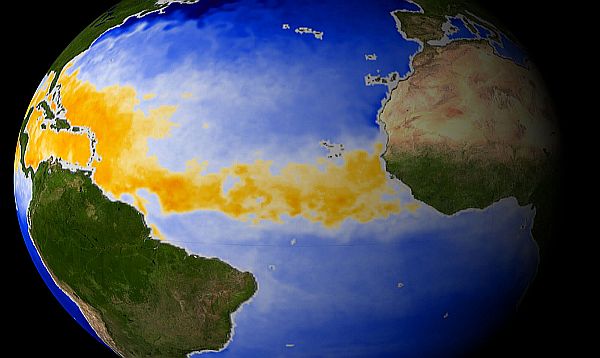Puerto Vallarta, Mexico - As many year residents of Puerto Vallarta, Mexico, it never ceases to amaze us when reading the negative and often blatantly dishonest publicity pertaining to Mexican resort areas. It usually has to do with drug related violence in one of the border cities.
A couple of years ago, when cruise boats avoided the Mexican Riviera for more than 10 weeks, it was associated with the virtually nonexistent swine flu, and most recently, hurricane Jova, which was hyped as potentially wiping out the vacation destination of Puerto Vallarta.
We have no idea whether the authors of these ridiculous articles have philosophical or financial motives, whether they're fresh out of journalism school and are just dreaming of things to write about, or better yet, perhaps they are escapees from the local substance abuse shelter! Whatever their problem is, it's disheartening to see their relentless barrage of nonsense continue infinitum.
As an example of the latest hysteria; recently, hurricane Jova passed within 15 miles of Puerto Vallarta. Like most Pacific hurricanes, it came off the Pacific Ocean out of the south west. It crossed land less than 100 miles south of PV as a Category 1 hurricane but rapidly dissipated as it moved over the 5,000 foot rugged terrain of the Sierra Madres.
By the time it passed Vallarta, the winds, which might have been clocked at 5 mph with gusts up to 8 mph, had zero effect on the resort destination. Furthermore, the entire day of partly cloudy skies produced less than an inch of rain.
However, by reading the following excerpts from some of the articles related to the effects of hurricane Jova on PV, you might be led to believe otherwise:
Hurricane Jova Rainy Weather Uncovers Two Bodies in Puerto Vallarta: Hurricane Jova is history. After it weakened to a tropical storm, it passed within 12 miles of one of the most popular vacation spots in the world, Puerto Vallarta. Puerto Vallarta escaped the storm without serious problems, but the heavy rains exposed two bodies that had been burried in shallow grave. (Comment: This author doesn't even waste his time to spell check his article!)
Hurricane Jova Blamed for at Least Two Deaths...Puerto Vallarta, Mexico: Hurricane Jova flooded the streets of Mexico's main Pacific port with torrential rain Wednesday, inundating popular beach resorts and killing at least two people in a mud slide.
(Comment: This author was a bit confused; he meant Barre de Navidad for the small beach resort village and Manzanillo as Mexico's main Pacific port city in his headline, not Puerto Vallarta!)
Mexico's Coastline of Tourist Retreats is Currently Being Ravaged by Hurricane Jova: Puerto Vallarta is experiencing maximum sustained winds of 100 mph. MSNBC.com reports that "the U.S. hurricane center in Miami warned that storm surge was expected to produce significant coastal flooding between the major seaport of Manzanillo, east of Barra de Navidad, and Cabo Corrientes, southwest of Puerto Vallarta."
(Comment: These 100 mph winds didn't blow a single leaf of our trees!)
Hurricane Jova Sweeps Across Mexico's Pacific Coast... Puerto Vallarta/Manzanillo, Mexico (Reuters): Hurricane Jova swept inland on Wednesday after making landfall as a Category Two storm on Mexico's Pacific coast late on Tuesday, dumping heavy rain that threatens to cause flash floods and mudslides. Puerto Vallarta's last big hurricane was Kenna in 2002, which hit with top winds of 144 mph (230 kph) and flooded streets close to the shore, causing damage that took authorities days to clear.
(Comment: This article was published and republished many times worldwide! The fact is, hurricane Kenna, in 2002, was a Category 5 when it hit the Mexican shoreline and it was the second most powerful hurricane to hit the west coast of Mexico in recorded history, however, it did not directly hit Vallarta; it came ashore in San Blas, Nayarit, a small village that lies directly on the Pacific Ocean about 80 miles north of PV. Puerto Vallarta did experience heavy rains, storm surges, flooding, and consequently some water damage but unlike what was suggested in the above article, the maximum wind felt in PV was below hurricane strength and nowhere near the suggested 144 mph!)
 |
| (AP Photo/Marco Ugarte) |
Global Montreal | Hurricane Jova makes landfall in the Mexican state of Jalisco as a Category 2 storm: A pedestrian walks on a flooded street in Puerto Vallarta, Mexico, Monday Oct. 10, 2011. Hurricane Jova strengthened to a major, Category 3 hurricane Monday as it marched toward Mexico's Pacific coast.
(Comment: Below is the actual weather data for the week of October 9th through October 15th, 2011 in Puerto Vallarta... the flooded street with ankle deep water that this writer was referring to might have been residual water from the 24.3 mm or less than an inch of rain received in Puerto Vallarta the day before, on October 9th, but it surely wasn't pre-hurricane Jova related. after all, on October 9th, hurricane Jova was still 400 miles offshore, southwest of Manzanillo, as can be seen HERE on the NOAA website. It should also be understood that on October 12th, the day hurricane Jova passed by PV, 20.7 mm or approximately 0.8 inch of rain fell in Vallarta while the average wind speed that day was 5 mph... not exactly what you would call ravaging hurricane conditions!)
 |
The above articles stated that the recent hurricane Jova created maximum sustained winds of 100 mph, inundating rains, mud slides, and dead bodies in Vallarta ...WOW... where do they get this stuff? It couldn't be further from the truth... in Puerto Vallarta on October 12, 2011, the day of hurricane Jova, it was 75°F, cloudy skies, calm, and less than an inch of rainfall.
Next, let's think about how they're able to conjure up and sell these hurricane stories. Most Americans and Canadians recognize both Puerto Vallarta and Cancun as a couple of beautiful Mexican resort areas with sandy beaches, palm trees, thatched roofed palapas, and margaritas.
Because all too many of us haven't exactly excelled in geography, many believe both of these resort beaches are a few miles up the road from Acapulco. Since hurricanes are quite common in Cancun and Cozumel, many just assume that hurricanes are apt to strike any of the Mexican beaches thus making all of the beaches somewhat dangerous at certain times of the year.
Now for the lesson in geography; the fact is, Cancun is located on the Yucatan Peninsula on the far eastern side of Mexico, while Puerto Vallarta is located in the center of the Mexican Riviera on the Pacific Ocean, on the western side of Mexico.
By way the crow flies, the two cities are almost 1,200 miles apart (probably an additional 200 miles by car.) In fact, Oklahoma City is closer to Puerto Vallarta than is Cancun. To put this distance in even better perspective, Puerto Vallarta and Cancun are farther apart than New Orleans and Toronto, Canada! (See the Google map)
Okay, now that we have a better understanding of where these beaches are relative to each other, let's consider the facts pertaining to topographical differences and consequently, the potential likelihood of hurricane conditions.
The Yucatan Peninsula is a huge, very flat, low level plateau barely exceeding a couple hundred meters at its highest point with Cancun located out on its eastern tip, essentially in the Gulf of Mexico; whereas, Puerto Vallarta is tucked securely on the inner shoreline of the 25 mile diameter Banderas Bay off the Pacific Ocean and protected to the south and southwest (where the tropical Pacific storms originate) by 5,000 foot tall rugged Sierra Madre Mountains which drop down directly to the water's edge.
Located virtually in the center of "hurricane alley," on average, Cancun is brushed or directly hit with a tropical storm or hurricane every 2.9 years; every 6.9 years for a direct hit hurricane having sustained winds of 75 mph or more and lasting for hours. The strength of the average hurricane in Cancun is a Category 3 with 111 mph winds.
On the other hand, Puerto Vallarta has been brushed by only 6 tropical storms and has not encountered any hurricane force winds for at least 60 years, or as long as they've been collecting such data.
The following are a series of three incredibly detailed hurricane history maps showing activity on both sides of Mexico for as long as the National Oceanic and Atmospheric Administration has been recording tropical storm and hurricane data:
1. On these High Resolution History Maps, it can be seen that there have been only 6 tropical storms in PV (sustained winds between 39 mph and 74 mph) during the past 60 years and all except one has been out of the southeast, having passed over more than 50 miles of Sierra Madre mountains before going through Vallarta... only one was a direct hit from the Pacific Ocean and its winds were well below hurricane strength. You'll also see that there has not been a single major hurricane in the Banderas Bay area during the past 60 years. On the other hand, these maps will clearly show that Cancun is virtually bombarded with tropical storms and being located in the center of "hurricane alley" in the Gulf of Mexico, major hurricanes are a serious threat every year.
2. HERE is another beautiful historical hurricane map of Mexico which, after clicking on hurricanes and then zooming in on PV and Cancun, you'll readily see the extreme differences.
3. If you're interested in reviewing the strength of the individual tropical cyclones and hurricanes that have hit the west coast of Mexico within 180 miles of PV over the past 60 years, please see table II-1 of the US Navy website for the Naval Research Laboratory.
In summarizing, it's a shame that we have to be so wary about everything we read. Hopefully not everything about Mexico is negative; the country and its people have so much to offer. Just don't accept it at face value when one of these brilliant journalists brags about watching the beautiful sunsets while sipping margaritas on the beaches of Cancun. Remember, the sun sets in the west and Cancun is facing east!
If you have any interest in sitting on a Mexican beach and sipping a margarita while watching an outrageous sunset, you'll want to do it in Puerto Vallarta where the sun seemingly plunges into the Pacific Ocean every night resulting in no two sunsets alike. However, if you're a hurricane hunter, forget it!
 Jim Scherrer has owned property in Puerto Vallarta, Mexico for 27 years and resided there for the past fourteen years. The mission of his series of nearly 80 articles pertaining to retirement in Puerto Vallarta is to reveal the recent changes that have occurred in Vallarta while dispelling the misconceptions about living conditions in Mexico. For the full series of articles regarding travel to and retirement in Vallarta as well as pertinent Puerto Vallarta links, please visit PVREBA.
Jim Scherrer has owned property in Puerto Vallarta, Mexico for 27 years and resided there for the past fourteen years. The mission of his series of nearly 80 articles pertaining to retirement in Puerto Vallarta is to reveal the recent changes that have occurred in Vallarta while dispelling the misconceptions about living conditions in Mexico. For the full series of articles regarding travel to and retirement in Vallarta as well as pertinent Puerto Vallarta links, please visit PVREBA.For more articles by Jim Scherrer, click HERE



